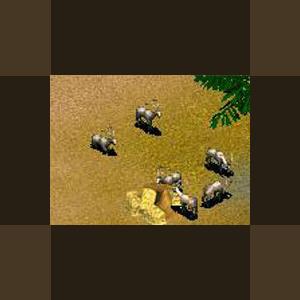About This File
The scimitar-horned oryx (Oryx dammah), named for its scimitar-shaped horns, weighs up to 220 kg (480 lb). The scimitar-horned oryx inhabits the sub-desert lands - the transition zones between true desert (Sahara) and the Sahel, with a rainfall of under 200 mm (8"). It is found in rolling dunes, grassy steppes and wooded inter-dunal depressions. It very rarely penetrates either true desert or true sahel country.
The scimitar-horned oryx eats a variety of grasses, as well as fruit and leaves. It is well adapted to arid lands, being able to go for 9 - 10 months without drinking water. Oryx has a number of adaptations to life in the desert. It utilizes the moisture in the vegetation it eats and its specialized kidneys minimize the loss of water through urine. Perspiration is minimized by allowing its body temperature to increase as high as 46.5 deg C (116 deg F) before body heat begins to be dissipated through perspiration.
During the Middle Ages the scimitar-horned oryx was probably the most numerous larger mammal of the semideserts just south of the Sahara. It was distributed from Mauritania in the west to the Red Sea in the east. Even as late as the 1920's and 30's it was considered common over much of its range from the Atlantic to the Nile. By the 1950's its range was fragmented, although substantial numbers survived in some areas. By the late 1960's it occurred only in Chad, Mali, Niger and the Sudan. By the late 1970's it only survived in scattered populations. In 1980 it was reported that only in Chad did it still occur in any numbers, with a small group in Niger, and perhaps a few dozen in Mali and Sudan. By the mid-1980's it was said to be on the brink of extinction and by 1999, it was thought to be extinct in the wild, although there was a recent unsubstantiated sighting of four animals in northern Niger.
The original decline of the scimitar-horned oryx started with climatic changes that led to the drying out of the Sahara. As the desert expanded to north and to south, it was pushed northward and southward, and desertification divided it into two isolated populations. The northern group probably was never as common as the southern group. The northern group may have been exterminated before 1900, although it was also reported to have survived in Tunisia until 1935.
The decline of the southern group worsened beginning with the arrival of Europeans in western and westcentral Africa in the latter part of the 19th century and the installation of numerous military posts in the arid regions. As firearms and horses increased, and then motorized vehicles, hunting began to take a major toll. The hunting was carried out by nomads for meat and hides for domestic consumption and trade, and by oil surveyors and troops. Not only were animals shot from motorized vehicles, sometimes with automatic weapons, but many of the slow-running desert animals died of heat exhaustion, calves were abandoned in the chase and unborn young aborted. In WWII, military operations probably led to considerable additional hunting to feed the armies. Finally, the civil war which began in Chad in the 1960's had a serious effect. In addition to the major impact of overhunting, the increasing presence of livestock, stimulated by deep wells for watering cattle on the edge of the Sahel, drove the oryx away from the pastures where it formerly obtained both food and water.
Currently, wild populations exist only in Israel (introduced populations), Tunisia (re-introduced populations) and a possible few may still occur in Niger.
2003 LAwebTek
Updated 2010-11-06
Just to save space with less in zip and smaller image.
Nothing new.



Recommended Comments
There are no comments to display.
Create an account or sign in to comment
You need to be a member in order to leave a comment
Create an account
Sign up for a new account in our community. It's easy!
Register a new accountSign in
Already have an account? Sign in here.
Sign In Now